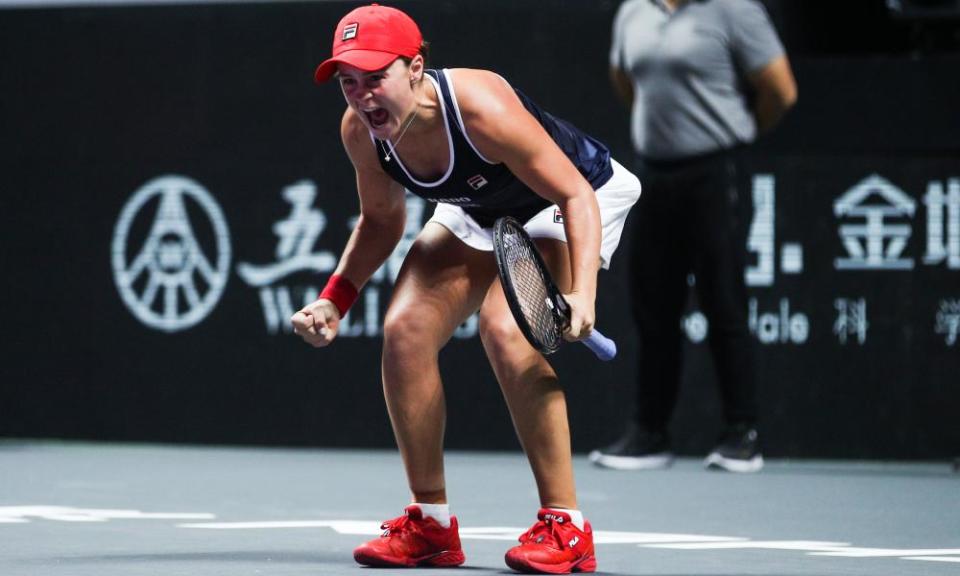Ashleigh Barty beats Elina Svitolina in WTA Finals to win game’s largest purse

Ashleigh Barty arrived for her final showdown in Shenzhen against Elina Svitolina having been beaten by her in all five of their previous meetings. But in the time since Svitolina last defeated her in March, Barty has won the French Open and reached No 1. On Sunday she showed emphatically just how far she has come by outclassing Svitolina 6-4, 6-3 to win the WTA Finals and its $4.42m (£3.42m) cheque, the biggest prize money in tennis history.
“Bizarre, if I’m being completely honest,” she said of her victory, according to the Women’s Tennis Association. “It feels like it’s been a year that just hasn’t stopped. It’s been a year of incredible ups and downs – I think more ups than downs. To cap it off with a very, very special night tonight in Shenzhen is really cool.”
Related: Ashleigh Barty passes $10m of prize money in unprecedented tennis season
It is difficult to think of many downs. Barty started the season ranked 15th without a grand slam quarter-final to her name and she finishes it as the best player in the world. Her rise to the summit has been unique in its swiftness – she did not break into the top 10 until March, when she won the Miami Open, yet four tournaments later she had won at Roland Garros and Birmingham to become world No 1.
In recent years the women’s game has seen many players struggle with the pressure and increased expectations inseparable from winning grand slam titles, yet Barty has played quality tennis throughout.
Against the defences of Svitolina on the notoriously slow courts of Shenzhen, the Australian produced one of the best performances of her career and took her game to yet another level. Both players came out serving well but it was Barty who patiently dictated from the baseline with her forehand, while lacing her game with swift forays to the net, drop shots and her skidding slice. She was first to break serve in the final game of the first set by which time she had fired 19 winners past Svitolina.

Barty’s improvements were particularly evident in the second set after she lost concentration at 1-1 and threw in a service game littered with unforced errors and a double fault that gave Svitolina a break. In previous years that would have unsettled her but she responded after the changeover by dominating Svitolina with her slice and producing three stunning points to break back. She won three games from 2-1 down and eventually served out the match to love.
“To come through a week like this you have to beat the best of the best,” she said. “It takes me back to some memories in Miami, where I felt like I did that for the first time, beating back-to-back top-10 players, having that really consistent week. I’ve grown and developed so much since that fortnight. To be able to bounce back after the disappointment after my match with Kiki [Bertens here] was really important.”
Barty has not suddenly transformed into a completely different player. Her serve is as fast as it was last year and her forehand carries the same wicked spin but she has learnt how to limit the low points in matches and which weapons to employ at the right time. In the past there were moments when she panicked during matches. Now she calmly solves her problems. In this tournament alone she bounced back from a torrid display against Bertens and confidently recovered from a set down against both Belinda Bencic and Karolina Pliskova.

While injury took its toll on her rivals, with four players forced to retire or withdraw through the week, Barty’s success is also a reflection of the most underrated facet of achieving tennis greatness: scheduling. While Bertens played 28 tournaments and burned out, Barty has played only 15 tour events in 2019. While most of her rivals were toiling through the Middle East in February, Barty trained and relaxed at home for a month. After her triumphant, exhausting spring she retreated back home and did not even look at a racket for two weeks.
When Barty returned for the US swing of the Tour a month after her fourth-round defeat at Wimbledon she looked rusty and was not back to her best until after the US Open. For some players that would have been unacceptable. For her it was fine. It was part of the bigger picture.
Barty’s early career will always be defined by the two years she retired from tennis after mounting pressure and loneliness led to depression. She returned determined to conduct her career on her terms, ensuring her mind was never overworked and she always had time to return home. Her success has shown it is possible to be successful without sacrificing everything in pursuit of greatness. She has done everything at her own pace and now stands as the best player in the world.

 Yahoo Sport
Yahoo Sport 





































